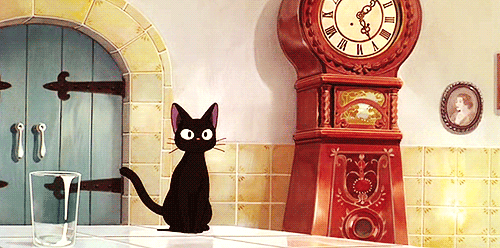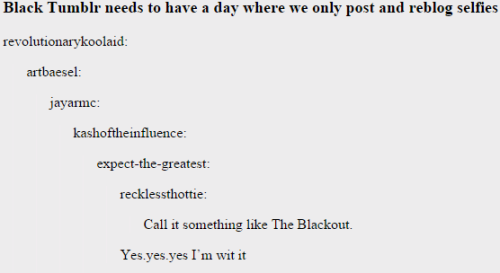Before you continue reading this, I want you to type two words into your search engine of choice: beautiful women. Then search “attractive men.”

Did you notice anything interesting about the results? Well, you may or may not have realized that an overwhelming majority of the people in the photographs are white. One has to scroll down for a while before a person of color pops up. And the people of color that are featured also have more Eurocentric features (light skin, smaller facial features). This says something about American standards of beauty and what’s wrong with them. So how do we fix this problem and remind Americans that The United States is comprised of beautiful people of several different races, sexual orientation, sizes, and religions? A few people online took matters into their own hands and started a movement.
How it All Began
One day in the lovely world of Tumblr, a young man by the name of T’von (@expect-the-greatest) posed an amazing idea on his dashboard by suggesting that there be a day that Black people just post selfies of themselves. The post received some buzz and a lot of reblogs until a young woman, named Marissa Rei (originally @recklessthottie, now @blkoutqueen), commented on T’von’s post with a recommendation of what to call this day of Black celebration. She suggested that it be called “The Blackout.” And thus, Blackout Day was born. T’von then created a schedule for #BlackoutDay to be the first Friday of every month, the first day being March 6, 2015.

Objectives, History, and Social Impact
The #BlackoutDay movement has several objectives. First, the campaign sets out to dispel the negative stereotypes of Black people that society and the media constantly preserve. Like many minorities groups in American society, Black people are judged by the negative stereotypes attributed to them instead of the greater positive aspects of Blackness. Also, individuality and the huge diversity within the Black community are often widely ignored by many people because they only pay attention to the negatives. Blackout Day serves as a day to remind people that there is not one image of a Black person. Black people come in different sizes, skin tones, religious beliefs, and abilities/disabilities.
Why #BlackOutDay is important. pic.twitter.com/Vf7Jm0Xy5H
— N*A*P*S (@RwhoweR) March 6, 2015
It's #blackoutday so why not post selfies 💁🏽 #blackout pic.twitter.com/WXOLd9Sy1D
— sabrina (@brinney_) September 21, 2015
Another objective of the Blackout campaign is to highlight Blackness and the beauty that needs to start being associated with it. For generations, Black people were seen as ugly and were not what people thought of when they thought of the word “beauty.” The Black people who were seen as beautiful had more features that reflected White people, like lighter skin, button noses, thinner lips, long hair or weave, etc. Black women were often seen as objects of sexual deviance because of the over-sexualization of the Black female body. Black men who had darker skinned complexions and/or muscular builds were automatically characterized as dangerous and ignorant. The list goes on. What is so sad about this is that many people still view Black people in that darkness. Black beauty is just starting to be celebrated in this country and the Blackout is maximizing that celebration.
This raises a question about beauty standards in American society. In that Google search of beautiful/attractive men and women, not only were the results mostly white people, they were only one type of white person. They were skinny, mostly blondes, and big breasted or muscular chested. Basically, to be considered beautiful in America, one has to have fair skin, long hair, and a tight figure. The Blackout creators want to redefine what it means to be beautiful. From such a young age, people are fed these images of beauty by the media and for so long. Personally, as a child I used to pray that God would make me look more White, especially in terms of my hair, because I didn’t think I was a pretty little girl. And it is so sad that many young children of color thought that way because of the lack of representation and acknowledgement of their beauty. The Blackout’s original creator, T’von acknowledged the fact that, yes, all people of color are beautiful, but in a society that has constantly ignored the beauties of being Black, it was important for him to focus on this community alone. “It’s past time for the beauty of Black people to be showcased,” he said. “I love all people of color, but this here is for us.”
Future looking real good for black girls 😍😍 #cuties pic.twitter.com/zOrczKCGls
— Black Girls ® (@BlackGirlsWinni) March 4, 2015
This social media campaign also sought out to increase solidarity in the Black community. Due to past and recent events that have affected the Black community, it is so important to remain unified as a group and maintain support. In the past, colorism has divided the Black community in a way that has transformed into something, frankly, very stupid. Colorism is a type of discrimination where people are treated differently according to their skin tones. This phenomenon stems back to slavery in America when lighter skinned slaves were allowed to work in the house when the dark skinned slaves had to work out in the field. The reason why they were treated better is because their lighter skin showed that they had White ancestry and were therefore more “worthy” of better treatment. In today’s society, Black people divide themselves based on their skin tones and certain characteristics are attributed to certain skin tones. An objective of the Blackout campaign is to make Black people forget about this silly division and simply acknowledge that Black people, regardless of their skin tones, are gorgeous.
#BlackoutDay is everyday.. pic.twitter.com/fdshdJQdlU
— IG: JohnMgbemena (@1youngcaesar) August 18, 2015
Preparing for the Blackout
In preparation for the first Blackout, T’von and Rei promoted the day on their social media and reached out to (and were noticed by) other well-known Tumblr blogs. The face and fingers behind the “Tumblr famous” blog, @whatwhiteswillneverknow, Nukirk, heard about the campaign and was eventually credited as one of co-creators of the movement for his contributions. He designed the graphics for the campaign for social media websites like Twitter, Facebook, Instagram, Vine, and of course Tumblr. According to the Blackout’s official website, Nukirk was also very involved in promoting the campaign and making it go viral.
A few days before the first official #BlackoutDay, a popular blog/website that promotes young artists of color, Color the Future, featured a piece about T’von and his creation. T’von spoke about his reason for starting Blackout Day and why it is so important. He attributed his inspiration to start this day to the lack of Black people he saw on his Tumlr dashboard. He saw Black celebrities but not many pictures of everyday people of color. “Where is their shine?” he asked.
Results and Conclusion
Blackout Day has been going strong across social media platforms for seven months now. According to the website, Marissa Rei has stepped up as the leader of the campaign, with Nukirk’s help with networking and constant advise from T’von. This campaign truly taught people a lot. Unfortunately, we learned that the American standard of beauty has not changed enough since the turn of the century. America is indeed a melting pot, no matter how cliché it sounds. The beautiful cultures and colors of this country need to be recognized by all people. Luckily, the Blackout campaign taught people more positive lessons. First off, it reminded people of color that a united front is so much harder to break; solidarity is key. Most of all it is teaching Black people to appreciate their own beauty rather than compare themselves to the standard.
My black is so beautiful 😍 #BlackOutDay #BLACKOUT pic.twitter.com/PU9XspGKPK
— Dai (@daisia_vu) March 7, 2015